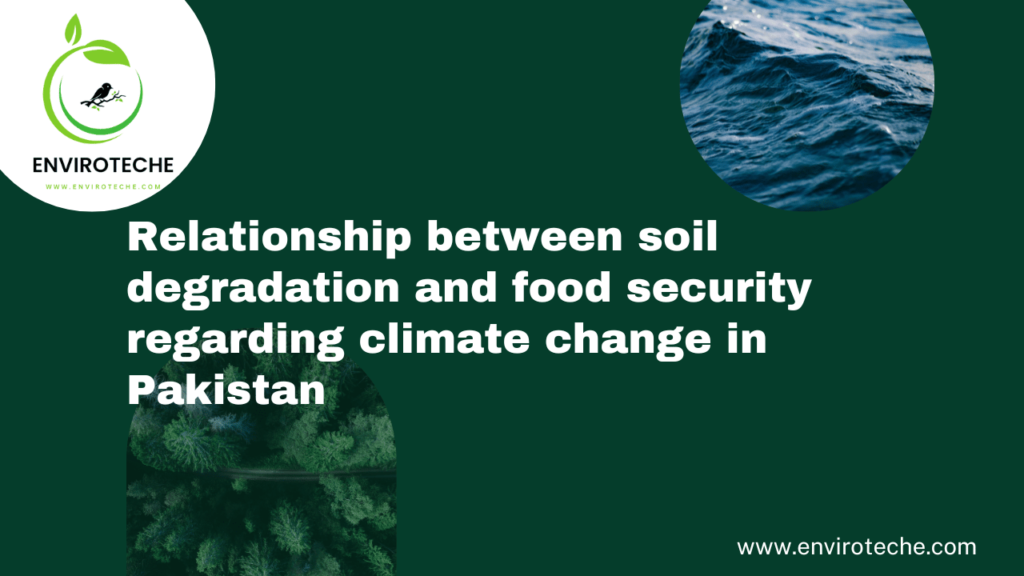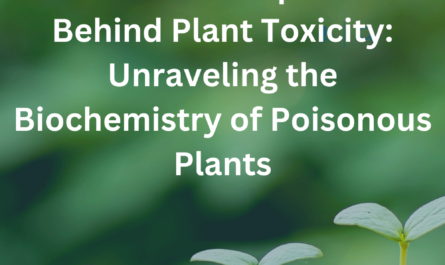
Irfan Haidri1, Muhammad Qasim1
Department of Environmental Sciences, Government College University Faisalabad1
Abstract
Soil carbon has been lost due to poor soil and crop management techniques. The first meter of soil depth stores roughly 1417 Pg of soil carbon globally, whereas above and below-ground flora and dead organic matter store roughly 456 Pg of soil carbon. Because of their greater ability for CO2 storage, organic-rich soils play a crucial part in limiting climate change.
The agricultural practices to blame for soil carbon losses are inadequate plugging practices, crop rotations, residue handling, nutrition, and insufficient usage of organic fertilizers. This results in the diminishing of soil organic matter in the form of carbon dioxide. In the form of N2O, CO2, and CH4, the agriculture sector is responsible for 25–30% of all global greenhouse gas emissions.
In this blog, we discussed about carbon sequestration and farming techniques like tillage, nutritional management, crop rotation, and residual management to reduce carbon.
Introduction
The act of plants absorbing atmospheric CO2 and subsequently storing it as organic matter in the soil is known as soil carbon (C) sequestration. Carbon exists in many different forms, such as carbon dioxide (CO2) in the environment, biomass from plants, soil organic matter, and dissolved in seawater. (Patil & Kumar, 2017). Soil organic carbon, main part of soil organic matter, can be classified as stable or labile.
The existence and contribution of soil organic matter are critical in the humification process, which results in the production of sustainable humus fractions and influences fertilization management. Around 1417 Pg of soil carbon remains in the top meter of soil worldwide, whereas 456 Pg of soil carbon is stored in both above- and below the ground vegetation, as well as dead organisms. (Yadav et al., 2021).
Agriculture has the ability to play a supporting part in decreasing greenhouse gas emissions, and agricultural soils may act as a sink for carbon dioxide sequestration through the adoption of proper agronomic methods. This is due to the fact that healthy soils with the high levels of organic matter have a better capacity for CO2 sequestration, making them helpful in the fight towards climate change. (Konstantinidis & Apostolakis, 2022).
Tillage
Tillage’s primary goal is to physically disturbing the upper soil layers in order to ready the soil bed, absorb fertilizers and crop leftovers, and control weeds. Tillage methods differ around the world due to factors such as soil properties, climate, cultivation techniques, and technological availability. Understanding the link between tillage, soil composition, and the soil organic matter dynamics are critical for agricultural soil carbon storage. (Bhattacharyya et al., 2022).
Tillage has a complex and often unpredictable impact on soil carbon dynamics. Human land agriculture has resulted in significant global declines in natural soil organic carbon (SOC), estimated to be 60% in temperate regions and 75% in tropical regions relative to original SOC levels. Conventional tillage practices were resulted in global soil carbon losses ranging from 30% to 50%, with some areas experiencing losses as low as twenty percent.
Plowing is the major source of soil organic carbon oxidation and CO2 emissions into the atmosphere. Furthermore, no steady states in conservation tillage techniques such as no-till, chisel plow, and moldboard plow may cause these approaches to fail to sequester an adequate quantity of soil organic carbon.(Hussain & Sohail, 2020). climate change
Nutrient management
Chemical fertilizers, especially N2O, contribute significantly to greenhouse gas emissions. In addition, fertilizer manufacturing and transportation result in greenhouse gas emissions. The proper application of fertilizers can increase agricultural yields and profitability. It is important to note that through the mineralization of soil organic carbon, agricultural soils have delivered around 50 Pg CO2 to the atmosphere. (Guenet et al., 2021). While fertilizers have been critical in enhancing agricultural output, research shows that chronic nitrogen fertilization reduces soil microbial activity.
It is critical to utilize fertilizers in a consistent and balanced manner to guarantee long-term soil fertility and crop productivity. Crop residues and nutrients, particularly nitrogen (N), also contribute to carbon sequestration, with the capacity to store between 21.3% and 32.5% of carbon.(Farooqi et al., 2018). The long-term impacts of continuous nitrogen fertilizer on soils, on the other hand, are complex and unknown. Long-term trials in Canada, for example, found that well-fertilized soils with optimal cropping systems sequestered SOC at rates ranging from 50 to 75 g cm2 per year. (Hussain & Sohail, 2020). climate change
Crop rotations
Crop rotation refers to the periodic succession of crops farmed on the same land area, with certain crops being cultivated for numerous years. Crop rotations, soils, and crop-related methods of management all have an impact on carbon sequestration. Soil organic material (SOM) is depleted in intensively cropping systems, but implementing required fertilization with NPK, organic amendments, and crop residue practices can increase the carbon sequestration by 5 to 10 Mg ha1 each year.
Carbon sequestration is facilitated by these changes, which typically comprise 10.7-18% C. Nitrogen replacement can be accomplished by including legume crops like peas, lentils, alfalfa, chickpeas, sesbania, and others. Incorporating legume cover crops into crop rotations, particularly those with carbon compounds that are the resistant to microbial degradation, which help to stabilize soil carbon. climate change
Residues management
Crop residues are the purposefully left unattached vegetative parts of the crop plants which decompose in agricultural fields following crop harvesting, with an estimated global yearly production of 3.4109 tons. If fifteen percent of these total wastes were used to add to the soil, the carbon (C) present in the soil may be increased (Sommer et al., 2018).
A ton of grain residue, for example, comprises between 11 and 21 kg of nitrogen (N), 1-4 kg of phosphorus (P), 7-31 kg of potassium (K), 4-7 kg of calcium (Ca), and 2-4 kg of magnesium (Mg). Mulching, on other hand, is employing unattached vegetation such as wheat straw, or even plastic sheets to protect plants from more evaporation and the cold stress while simultaneously boosting soil organic matter (SOM) contents (Restrepo-Osorio et al., 2019).
Management of the soil biota
Soil microbial activities are important in biological carbon sequestration due to they improve soil physical, biological and chemical characteristics, resulting in higher soil quality. Soil biota, which comprised of a wide variety of micro- and microorganisms, is the living part of the soil ecosystem. These organisms interact with one another and with plants to provide nutrients and other benefits. (Roy et al., 2017).
Furthermore, the physical makeup and byproducts play very important role in the soil development and structure. They also actively participate in the breakdown of organic matter and aid in the transformation of the organically bound nitrogen and minerals, both of which are required for plant uptake. These organisms use effective biological control mechanisms to not only maintain their own populations, but also to handle incoming microbes.(Roy et al., 2017).
Conclusion
CO2 levels are rising at a rate of 2.3 ppm per year, contributing to the pollution and global warming. Agriculture were responsible for up to thirty percent of the GHG emissions. Maintaining sustainable agricultural practices were critical to human survival. No-tillage or decreased cultivation, nutrient management, crop rotations, green manuring, compost application, forestation, and other agricultural management approaches can all help with carbon sequestration. Adopting these measures not only increases agricultural yields but also increases farmer revenue. climate change
References
Bhattacharyya, S. S., Ros, G. H., Furtak, K., Iqbal, H. M. N., & Parra-Saldívar, R. (2022). Soil carbon sequestration–An interplay between soil microbial community and soil organic matter dynamics. Science of The Total Environment, 152928. climate change
Farooqi, Z. U. R., Sabir, M., Zeeshan, N., Naveed, K., & Hussain, M. M. (2018). Enhancing carbon sequestration using organic amendments and agricultural practices. Carbon Capture, Utilization and Sequestration, 17. climate change
Guenet, B., Gabrielle, B., Chenu, C., Arrouays, D., Balesdent, J., Bernoux, M., Bruni, E., Caliman, J., Cardinael, R., & Chen, S. (2021). Can N2O emissions offset the benefits from soil organic carbon storage? Global Change Biology, 27(2), 237–256. climate change
Hussain, I., & Sohail, M. (2020). Soil Carbon Sequestration through Agronomic Management Practices. CO2 Sequestration, 5. climate change
Konstantinidis, K. A., & Apostolakis, I. A. (2022). The Impact of Virtual Reality in Medical Ionizing Radiation Sciences Education: A Systematic Review of the International Literature. European Journal of Engineering and Technology Research, 19–25. climate change
Patil, P., & Kumar, A. K. (2017). Biological carbon sequestration through fruit crops (perennial crops-natural “sponges” for absorbing carbon dioxide from atmosphere). Plant Archives, 17(2), 1041–1046. climate change
Restrepo-Osorio, A., Álvarez-López, C., Jaramillo-Quiceno, N., & Fernández-Morales, P. (2019). Agrotextiles and crop protection textiles. High Performance Technical Textiles. Wiley, Hoboken, NJ. Https://Doi. Org/10.1002/9781119325062. Ch10. climate change
Roy, S., Roy, M. M., Bano, R., & Saxena, P. (2017). Soil microarthropods: Biodiversity and role in grassland and agroforestry ecosystems. Agroforestry: Anecdotal to Modern Science, 669–689. climate change
Sommer, R., Paul, B. K., Mukalama, J., & Kihara, J. (2018). Reducing losses but failing to sequester carbon in soils–the case of Conservation Agriculture and Integrated Soil Fertility Management in the humid tropical agro-ecosystem of Western Kenya. Agriculture, Ecosystems & Environment, 254, 82–91. climate change
Yadav, G. N., Sammauria, R., Sharma, S., Yadav, S. L., Pathan, A. R. K., Singh, J., & Shekhawat, P. S. (2021). Crop and soil management improves carbon sequestration. climate change
Check Other Schlorships:


